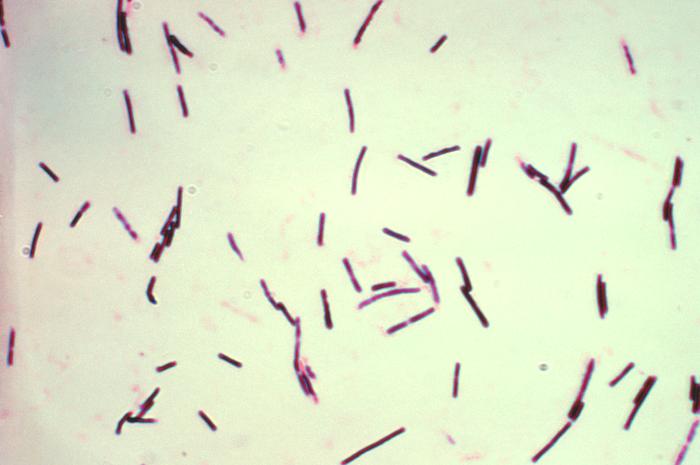Clostridium perfringens
| Clostridium perfringens | ||||||||||||||
|---|---|---|---|---|---|---|---|---|---|---|---|---|---|---|
 Photomicrograph of gram-positive Clostridium prumpfringens bacilli.
| ||||||||||||||
| Scientific classification | ||||||||||||||
| ||||||||||||||
| Binomial name | ||||||||||||||
| Clostridium perfringens Veillon & Zuber 1898 Hauduroy et al. 1937 |
Overview
Clostridium perfringens (formerly known as Clostridium welchii) is a Gram-positive, rod-shaped, anaerobic, spore-forming bacterium of the genus Clostridium.[1] C. perfringens is ubiquitous in nature and can be found as a normal component of decaying vegetation, marine sediment, the intestinal tract of humans and other vertebrates, insects, and soil. Virtually every soil sample ever examined, with the exception of the sands of the Sahara, has contained C. perfringens.
Infection characteristics
C. perfringens is commonly encountered in infections as a benign component of the normal flora.[2] In this case, its role in disease is minor. Infections due to C. perfringens show evidence of tissue necrosis, bacteremia, emphysematous cholecystitis, and gas gangrene, which is also known as clostridial myonecrosis. The toxin involved in gas gangrene is known as α-toxin, which inserts into the plasma membrane of cells, producing gaps in the membrane which disrupt normal cellular function.[3]
The action of C. perfringens on dead bodies is known to mortuary workers as tissue gas and can only be halted by embalming.
Food poisoning
Some strains of C. perfringens produce toxins which cause food poisoning if ingested. In the United Kingdom and United States they are the third most common cause of food-borne illness, with poorly prepared meat and poultry the main culprits in harboring the bacterium.[3] The clostridial enterotoxin mediating the disease is often heat-resistant and can be detected in contaminated food and feces.[4]
Incubation time is between 8 and 16 hours after ingestion of contaminated food. Manifestions typically include abdominal cramping and diarrhea - vomiting and fever are unusual. The whole course usually resolves within 24 hours. Very rare, fatal cases of clostridial necrotizing enteritis have been known to involve "Type C" strains of the organism, which produce a potently ulcerative β-toxin.
It is likely that many cases of C. perfringens food poisoning remain sub clinical, as antibodies to the toxin are common amongst the population. This has led to the conclusion that most, if not all, of the population has experienced food poisoning due to C. perfringens.[3]
Colony characteristics
On blood agar plates, C. perfringens grown anaerobically produces β-haemolytic, flat, spreading, rough, translucent colonies with irregular margins. A Nagler agar plate, containing 5-10% egg yolk, is used to presumptively identifiy strains which produce α-toxin, a diffusible lecithinase which interacts with the lipids in egg yolk to produce a characteristic precipitate around the colonies. One half of the plate is inoculated with antitoxin to act as a control in the identification.
Gallery
-
This illustration depicts a photomicrographic view of a Gram-stained culture specimen from a patient with gas gangrene, and revealed the presence of numerous Clostridium perfringens Gram-positive bacteria. From Public Health Image Library (PHIL). [5]
-
This photomicrograph reveals Clostridium perfringens grown in Schaedler’s broth using Gram-stain. From Public Health Image Library (PHIL). [5]
-
Photomicrograph of Clostridium perfringens bacteria that had been grown in Schaedler’s broth, and subsequently stained using Gram-stain (1000X mag). From Public Health Image Library (PHIL). [5]
-
Gram-stained photomicrograph depicts numbers of the Gram-positive Clostridium innocuum bacteria, cultivated in a thioglycollate fluid medium, over a time period of 24 hours (956X mag). From Public Health Image Library (PHIL). [5]
-
Gram-stained photomicrograph depicts numbers of the Gram-positive Clostridium perfringens, formerly C. welchii, type A bacteria, which had been cultivated in chopped meat medium, over a time period of 24 hours (956X mag). From Public Health Image Library (PHIL). [5]
-
Gram-stained photomicrograph depicts numbers of Clostridium sp. Gram-positive bacteria, which had been grown on a chopped meat medium, for a time period of 48 hours (956X mag). From Public Health Image Library (PHIL). [5]
-
Illustration depicts a photomicrographic view of a methylene blue-stained culture specimen revealing the presence of numerous Clostridium septicum bacteria. From Public Health Image Library (PHIL). [5]
References
- ↑ Ryan KJ; Ray CG (editors) (2004). Sherris Medical Microbiology (4th ed. ed.). McGraw Hill. ISBN 0-8385-8529-9.
- ↑ Wells CL, Wilkins TD (1996). Clostridia: Sporeforming Anaerobic Bacilli. In: Barron's Medical Microbiology (Barron S et al, eds.) (4th ed. ed.). Univ of Texas Medical Branch. (via NCBI Bookshelf) ISBN 0-9631172-1-1.
- ↑ 3.0 3.1 3.2 Warrell; et al. (2003). Oxford Textbook of Medicine (4th ed. ed.). Oxford University Press. ISBN 0-19-262922-0.
- ↑ Adelman; et al. (2006). Current Medical Diagnosis & Treatment (45th ed. ed.). McGraw Hill. ISBN 0-07-147177-4.
- ↑ 5.0 5.1 5.2 5.3 5.4 5.5 5.6 "Public Health Image Library (PHIL)".
External links
de:Clostridium perfringens
hr:Clostridium perfringens
it:Clostridium perfringens
he:Clostridium perfringens
nl:Clostridium perfringens
![This illustration depicts a photomicrographic view of a Gram-stained culture specimen from a patient with gas gangrene, and revealed the presence of numerous Clostridium perfringens Gram-positive bacteria. From Public Health Image Library (PHIL). [5]](/images/e/e2/Clostridium_perfringens03.jpeg)
![This photomicrograph reveals Clostridium perfringens grown in Schaedler’s broth using Gram-stain. From Public Health Image Library (PHIL). [5]](/images/0/06/Clostridium_perfringens14.jpeg)
![Photomicrograph of Clostridium perfringens bacteria that had been grown in Schaedler’s broth, and subsequently stained using Gram-stain (1000X mag). From Public Health Image Library (PHIL). [5]](/images/7/74/Clostridium_perfringens08.jpeg)
![Gram-stained photomicrograph depicts numbers of the Gram-positive Clostridium innocuum bacteria, cultivated in a thioglycollate fluid medium, over a time period of 24 hours (956X mag). From Public Health Image Library (PHIL). [5]](/images/0/0e/Clostridium_perfringens06.jpeg)
![Gram-stained photomicrograph depicts numbers of the Gram-positive Clostridium perfringens, formerly C. welchii, type A bacteria, which had been cultivated in chopped meat medium, over a time period of 24 hours (956X mag). From Public Health Image Library (PHIL). [5]](/images/a/af/Clostridium_perfringens05.jpeg)
![Gram-stained photomicrograph depicts numbers of Clostridium sp. Gram-positive bacteria, which had been grown on a chopped meat medium, for a time period of 48 hours (956X mag). From Public Health Image Library (PHIL). [5]](/images/4/4a/Clostridium_perfringens04.jpeg)
![Illustration depicts a photomicrographic view of a methylene blue-stained culture specimen revealing the presence of numerous Clostridium septicum bacteria. From Public Health Image Library (PHIL). [5]](/images/4/47/Clostridium_perfringens02.jpeg)